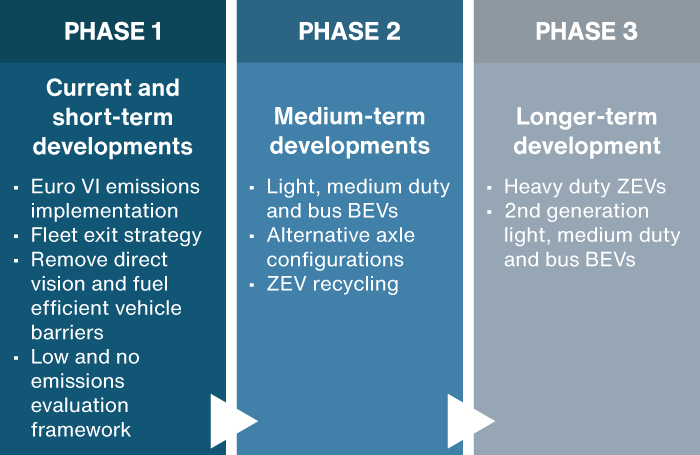Low and Zero Emission Vehicles (LZEVs) is a broad term to describe vehicles such as, battery electric vehicles (BEVs), and hybrid electric vehicles (HEVs). Other technologies such as hydrogen engines, hydrogen fuel cell electric motor, and blended hydrogen/diesel engines are also captured.
Future Heavy Vehicle Roadmap
The Future Heavy Vehicle Roadmap was developed as a single reference point to capture:
- heavy vehicle-related developments
- a preliminary regulatory scan to identify potential barriers and
- suggest a broad grouping to assist in prioritisation of reform work.
One of the themes identified was the emergence of LZEVs.
In addition to reducing environmental impacts, LZEVs are also expected to provide other benefits not typically considered, such as:
- reduced vehicle maintenance
- increased permitted operating hours (currently restricted in some areas due to noise)
- decreased driver fatigue (less vibration, noise, etc).
To accompany this shift towards LZEVs, there has also been a significant investment made towards increasing vehicle efficiency and reducing the emissions of diesel-powered vehicles.

Access arrangements
To support the industry transition to zero-emission vehicles, the following jurisdictions have outlined access arrangements for low and zero-emission heavy vehicles.
| State or territory | Eligible vehicles | Axle mass limits* | Details |
|---|---|---|---|
|
New South Wales |
Rigid trucks Prime mover and semitrailer combinations B-doubles with trailers fitted with tri-axle groups |
Single steer axle – up to 8.0 tonnes Tandem drive axle group – up to 18.5 tonnes |
Access via New South Wales Class 3 Zero Emission Vehicle Mass and Dimension Exemption Notice More information: NSW Freight Hub – Towards Net Zero Emissions Freight Policy | NSW |
|
Queensland |
Rigid trucks (3-axles) Prime mover and semitrailer combination |
Single steer axle – up to 8.0 tonnes Tandem drive axle group – up to 18.5 tonnes |
Access via permit under the Queensland zero emission heavy vehicle permit-based scheme |
|
South Australia |
Prime mover and semitrailer combinations B-doubles Road trains |
Single steer, tandem drive prime movers:
Twinsteer, tandem drive prime movers:
|
Access via permit to pre-approved networks More information: Low and Zero emission HV trial | DIT |
|
Victoria |
Volvo FM or FH prime mover and semitrailer combination |
Single steer axle – up to 7.5 tonnes |
Access via permit to pre-approved networks More information: Freight Transport Decarbonisation | VIC |
|
Western Australia |
Single heavy vehicle powered by an electric motor |
Single steer axle – up to 7.1 tonnes |
More information: Electric and Safer Vehicles Order (refer to page 1686). |
| *Note: Maximum mass limits for steer axles are impacted by tyre size. Refer to each jurisdictional scheme for more details. | |||

 Accessibility tools
Accessibility tools

